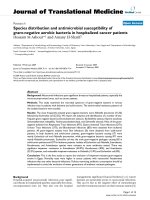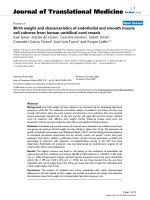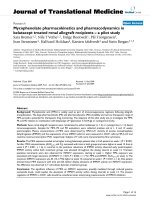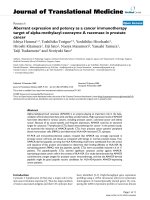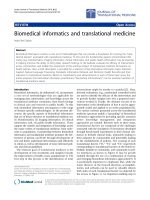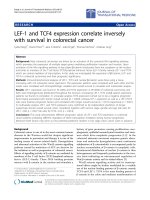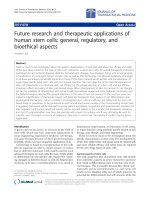báo cáo hóa học: "Toe clearance and velocity profiles of young and elderly during walking on sloped surfaces" potx
Bạn đang xem bản rút gọn của tài liệu. Xem và tải ngay bản đầy đủ của tài liệu tại đây (859.77 KB, 10 trang )
JNER
JOURNAL OF NEUROENGINEERING
AND REHABILITATION
Khandoker et al. Journal of NeuroEngineering and Rehabilitation 2010, 7:18
/>Open Access
RESEARCH
BioMed Central
© 2010 Khandoker et al; licensee BioMed Central Ltd. This is an Open Access article distributed under the terms of the Creative Com-
mons Attribution License ( which permits unrestricted use, distribution, and reproduc-
tion in any medium, provided the original work is properly cited.
Research
Toe clearance and velocity profiles of young and
elderly during walking on sloped surfaces
Ahsan H Khandoker*
1
, Kate Lynch
2
, Chandan K Karmakar
1
, Rezaul K Begg
2
and Marimuthu Palaniswami
1
Abstract
Background: Most falls in older adults are reported during locomotion and tripping has been identified as a major
cause of falls. Challenging environments (e.g., walking on slopes) are potential interventions for maintaining balance
and gait skills. The aims of this study were: 1) to investigate whether or not distributions of two important gait variables
[minimum toe clearance (MTC) and foot velocity at MTC (Vel
MTC
)] and locomotor control strategies are altered during
walking on sloped surfaces, and 2) if altered, are they maintained at two groups (young and elderly female groups).
Methods: MTC and Vel
MTC
data during walking on a treadmill at sloped surfaces (+3°, 0° and -3°) were analysed for 9
young (Y) and 8 elderly (E) female subjects.
Results: MTC distributions were found to be positively skewed whereas Vel
MTC
distributions were negatively skewed for
both groups on all slopes. Median MTC values increased (Y = 33%, E = 7%) at negative slope but decreased (Y = 25%, E
= 15%) while walking on the positive slope surface compared to their MTC values at the flat surface (0°). Analysis of
Vel
MTC
distributions also indicated significantly (p < 0.05) lower minimum and 25
th
percentile (Q1) values in the elderly
at all slopes.
Conclusion: The young displayed a strong positive correlation between MTC median changes and IQR (interquartile
range) changes due to walking on both slopes; however, such correlation was weak in the older adults suggesting
differences in control strategies being employed to minimize the risk of tripping.
Background
Locomotor behaviour of walking gait is challenged by
environmental factors including sloped surfaces. Lower
extremity biomechanics for slope walking in humans
have been used to provide insight into neural control
strategies for different locomotor tasks [1-4]. Recently
control strategies during slope walking were analysed
using joint kinematics, kinetics and EMG activity results
while walking on both negative and positive slopes [5]
which suggested that the central nervous system uses dif-
ferent control strategies to successfully walk on slopes.
While the differences in lower extremity biomechanics
between slope and level walking have the potential to
provide insight into these new control strategies, how-
ever, no literature has been presented to describe the con-
trol strategies for minimizing the risk of tripping in the
elderly during slope walking. It has been well docu-
mented in the literature that ageing contributes to altered
control mechanism of human locomotor balance, which
in turn can influence gait patterns. Most falls in older
adults are reported during locomotion. Tripping whilst
walking is the most commonly reported cause of falls [6],
accounting for 53% of falls in healthy older adults [7].
Additionally, falls in the elderly might be linked to
declines in the balance control function due to walking
on challenging environments. In our earlier studies [8-
11], we have identified minimum toe clearance (MTC) as
an important gait parameter associated with trip-related
falls in older population in successful negotiation of the
environment in which we walk. MTC while walking
occurs during the mid-swing phase of the gait cycle, and
is defined as the minimum vertical distance between the
lowest point under the front part of the shoe/foot and the
ground. During this MTC event, the foot travels very
close to the walking surface and MTC fluctuation has the
potential to cause tripping, especially for unseen obsta-
* Correspondence:
1
Department of Electrical & Electronic Engineering, The University of
Melbourne, Melbourne, VIC 3010, Australia
Full list of author information is available at the end of the article
Khandoker et al. Journal of NeuroEngineering and Rehabilitation 2010, 7:18
/>Page 2 of 10
cles. Foot velocity at MTC has been reported to be at its
maximum previously [12], however, there have not been
any previous attempts to characterize gait control mecha-
nisms using this measure. Foot velocity at MTC repre-
sents an important dynamic measure of the foot at the
critical event which potentially determines whether the
consequent of a trip would be a fall or not.
We have reported that the changes in MTC central ten-
dency/variability are the possible strategies adopted by
elderly individuals to minimize tripping risk during level
walking [8-10]. However, so far research on tripping risk
and MTC analysis [8-10] has been conducted on flat sur-
faces (laboratory walkways or treadmills with 0° inclina-
tion). Previous investigation [3] has shown the human
locomotion pattern to be highly adaptive to varying ter-
rains. As our surroundings are by no means flat and also
given the fact that negotiating sloped surfaces is a neces-
sity during our everyday locomotion, analysis into slope
walking is one way to understand adaptive gait control
mechanism and to further explore the causes of trips and
falls. In this research, we hypothesize that walking on
sloped surfaces would induce altered balance control
strategies to minimize the risk of tripping.
This study, therefore, investigated the profiles of two
gait measures [MTC and foot velocity at MTC (Vel
MTC
)]
on positive and negative slopes. The purpose of this study
was twofold. Firstly, to investigate whether or not distri-
butions of two important gait variables and locomotor
control strategies to minimize the risk of tripping are
altered during walking on sloped surfaces. Secondly, if
these strategies exist, are they maintained at young and
elderly female age groups or not.
Methods
Subjects and experimental design
Nine healthy young female volunteers (age (yr) = 23.9 ±
1.7) were recruited via responding to volunteer notices
within Victoria University. Plus eight healthy elderly
female volunteers over the age of 65 years (age (yr) = 69.1
± 5.12) were recruited from retirement villages, older
adults' aqua aerobics classes and advertisements placed in
a monthly senior citizens' newspaper. All participants
were female and they undertook informed-consent pro-
cedures as approved by the Victoria University Human
Research Ethics Committee. The study protocol was
designed to analyse young and elderly subjects walking
on a trimline 7600 motorised treadmill at the gradients of
-3°, 0° and +3° for 7 minutes. 3° gradient was selected as
most walkway ramps are approximately ± 2.9° [13]. All
participants were independent living, led an active life-
style and had no history of falls in the last 2 years, whilst
being free of cardiac, musculoskeletal, or orthopaedic
troubles that may affect balance or locomotion. Partici-
pants wore their own flat, comfortable shoes suitable for
walking. This was to ensure an accurate representation of
everyday walking, with a heel no higher than 2.5 cm, to
minimize shoe effects on the results. Our study protocol
had participants walk at their preferred walking speed
(PWS) [14,15], which was kept constant across all three
gradients. The ranges (min~max) of PWS (treadmill
speed) for the young and elderly subjects were 3.0~4.0
km/h (mean = 3.51 km/h) and 1.7~5.0 km/h (mean = 3.14
km/h) respectively.
MTC Gait Data
Whilst participants walked at the gradients of -3°, 0° and
+3°, toe clearance data were collected at 100 Hz using
Optotrak Certus motion analysis system (Northern Digi-
tal Inc., Canada). Fig. 1 shows marker positions that were
used to predict the lowest point on the shoe. The
Optotrak system using infrared markers (IRED) and
through the construction of rigid bodies and virtual
markers, is able to calculate the 3D position of markers
(real or virtual) in real time. Northern Digital Inc (NDI)
Toolbench was used to construct a rigid body which con-
sists of 4 IRED's (L1, L2, L3 and L4) attached to the shoe.
Using the rigid body NDI Toolbench is able to establish
the co-ordinates of a point in close proximity, without the
presence of a real marker, this point is known as 'virtual
marker'. The real markers (IRED) may not accurately rep-
resent the lowest point of the shoe. Constructing a virtual
marker is achieved through the placement of a tip probe
on the desired points (V1, V2, V3; first, third and fifth
metatarsals) whereby the computer is able to calculate the
location in respect to the origin of the rigid body. Each
position location was determined through palpation on
the shoe. Toe trajectory and clearance (for each location)
over the walking surface for each gait cycle were calcu-
lated using a QBasic software program. MTC was deter-
mined for each marker location and the minimum of the
3 toe locations (V1, V2 and V3) was used for further anal-
ysis. Horizontal velocity at MTC (VelMTC) was then cal-
Figure 1 Optotrak marker positions. Optotrak marker positions that
were used to predict the lowest point on the shoe. L1, L2, L3 and L4
represent the real markers located on rigid body. V1, V2 and V3 (first,
third and fifth metatarsals) represent the virtual markers.
Khandoker et al. Journal of NeuroEngineering and Rehabilitation 2010, 7:18
/>Page 3 of 10
culated using the central difference method. 2D and 3D
accuracy of the motion analysis system used in this study
were 0.1 mm and 0.15 mm respectively at 2.25 m distance
/>specs.php.
Data Analysis
The total number of gait cycles analysed per subject (i.e.,
the number of MTC data and hence Vel
MTC
data) varied
across the subjects due to their individual preferred walk-
ing speed. The range of gait cycles measured was 358 to
567. The extracted MTC and Vel
MTC
data from multiple
steps at each gradient was plotted in distribution. Data
distribution statistics were determined, including mini-
mum (min), maximum (max), mean(mean), median
(median), standard deviation (STD), 25
th
percentile (Q1),
75
th
percentile (Q3), interquartile range (IQR), upper
quartile range (UQR), lower quartile range (LQR), skew-
ness (S) and kurtosis (K). S > 0 means skew to the right
and K > 0 means a leptokurtic/peaked distribution. As
MTC [8] and Vel
MTC
data were not normally distributed,
Kruskal-Wallis non-parametric test (one way analysis of
variance) was used to test the effect of age on descriptive
statistics of MTC and Vel
MTC
separately at each slope
considering PWS as a covariate. Associations between
descriptive statistics were determined using Spearman
coefficient ρ [16]. Friedman's nonparametric two-way
analysis of variance was employed to test the effect of
slopes on descriptive statistics of MTC and Vel
MTC
for the
two aged groups. To test multi comparisons among three
slopes' descriptive statistics, a bonferroni post-hoc test
was applied after Friedman test shows significance at p <
0.05.
Results
Fig. 2 presents medianMTC and medianVel
MTC
for all 17
participants in two groups. It shows there were consider-
able variation in median values of MTC and Vel
MTC
of
individual participants walking at flat as well as sloped
surfaces.
MTC histograms at various slopes
Fig. 3 shows MTC histograms for young and elderly
groups during walking on various sloped surfaces. These
plots reveal some obvious qualitative differences between
two groups such as differences in variability and central
tendency of MTC. Descriptive statistics of MTC and
Vel
MTC
while walking at positive, flat and negative slopes
for young and elderly groups are presented in Table 1.
Friedman's nonparametric two-way analysis of variance
test results show that maxMTC, meanMTC, STDMTC
and LQRMTC at -3° slope were significantly higher than
that at +3° in the young group.
Vel
MTC
histograms at various slopes
Fig. 4 shows histograms of Vel
MTC
for young and elderly
populations during walking on various sloped surfaces.
According to the results presented in Table 1, median-
Vel
MTC
of both groups was found to be decreased (1.5%
for young group; 2.3% for elderly group) at negative slope
but remained relatively unchanged at positive slope. IQR
and STD of Vel
MTC
in both groups remained unchanged
at slopes. However, maxVel
MTC
at -3° slope in young
group was found to be significantly lower than that at
flat(0°) surface (Table 1). Q1Vel
MTC
and minVel
MTC
at all
conditions (+3°, 0° and -3°) were found be significantly (p
< 0.05) lower in the elderly group. Also, central tendency
measures (meanVel
MTC
, medianVel
MTC
and modeVel
MTC
)
of Vel
MTC
in the elderly group walking at negative slope(-
3°) were found to be significantly (p ≤ 0.05) lower than
that of the young group. No significant differences
between groups were found for other measures. However,
it is interesting to note that distributions of MTC and
Vel
MTC
in both groups are oppositely skewed (Table 1).
Relationships between the changes of medianMTC and
IQRMTC due to changes of slopes
Fig. 5 shows that walking on both slope changes in down-
ward (from 0° to -3°) (panel A) and upward (from 0° to
+3°) (panel B) induced significant correlations (ρ = 0.93, p
= 0.0003; ρ = 0.85, p = 0.0038) between changes of medi-
anMTC and IQRMTC for the young adults. In compari-
son, there are no such significant relationships found in
the elderly adults due to changes in slopes (panel C and
D).
Correlations among the measures of MTC and Vel
MTC
Table 2 summarize the correlations among (median, IQR)
of MTC and (median, IQR) of Vel
MTC
respectively within
each age group. There were significant (p = <0.01) posi-
tive relationship of IQRVel
MTC
with medianMTC(ρ =
0.83) and IQRMTC(ρ = 0.81) in the young adults while
walking at 0° slope (Table b2b). However, no such signifi-
cant relationships were found in the same group while
walking at sloped surfaces (-3° and +3°) (Table a, c2a, c).
In the elderly group, in contrast, no significant relation-
ships among descriptive statistics of MTC and median-
Vel
MTC
, IQRVel
MTC
were found (Table 2).
Discussion
The results of this study highlight the implications of two
gait variables, i.e. MTC and foot velocity at MTC
(Vel
MTC
) that have been utilized to characterize gait pat-
terns of the young and elderly subjects during walking at
various slopes. The trajectory of the foot during gait is a
precise end-point control task. MTC has close linkage
with tripping risks during walking and its characteristics
Khandoker et al. Journal of NeuroEngineering and Rehabilitation 2010, 7:18
/>Page 4 of 10
have been used to effectively recognize trip related fallers
from non-fallers [9,15]. Furthermore, foot velocity at
MTC represents an important dynamic measure of the
foot at the critical event which potentially determines
whether the consequent of a trip would be a fall or not.
For example, foot moving with a high horizontal velocity
is more likely to result in a fall following contact with an
over ground obstacle or obstruction. Horizontal foot
velocity at MTC has been reported to be at its maximum
previously [12], however, there have not been any previ-
ous attempts to characterize gait control mechanisms
using this measure.
Figure 2 Median values of MTC and Vel
MTC
at slopes. Median values of MTC and Vel
MTC
of individual participants during walking at -3°>, 0° and +3°
slopes.
Khandoker et al. Journal of NeuroEngineering and Rehabilitation 2010, 7:18
/>Page 5 of 10
Strategic relationships
a) Strategies employed at flat surface (0°)
Begg [8] demonstrated that MTC distribution statistics
could provide insight into possible strategies employed by
individuals to exert control on the foot at MTC walking
on flat surface (0°). Out of the strategies, the simplest and
most effective one is the Median-IQR strategy i.e., to
reduce the variability if the foot comes very close to the
ground. The results from the present study support the
possible strategies suggested by the previous study. For
example, during flat surface walking, although statisti-
cally not significant, medianMTC and IQRMTC were
both lower for the elderly group compared to young
group. This suggest that the elderly could have applied
increased control by lowering variability (i.e. less IQR)
due to their lower MTC height over the ground to avoid
potential tripping risk [8].
b) Strategies employed at negative slope (-3°)
At negative slope, young group demonstrated positive
correlation of change in medianMTC with the change in
IQRMTC (in Fig. 5A). Although intra-subject variation
can be noticed, but the overall strategic measure of strong
Figure 3 MTC histograms. MTC histogram of the young group (left panels) at (A) -3° slope (N = 3714), (B) 0° (N = 3695) and (C) +3° slope (N = 3349)
and of the elderly group (right panels) at (D) -3° slope (N = 3313), (E) 0° (N = 3243) and (F) +3° slope (N = 3211). N = number of samples.
Khandoker et al. Journal of NeuroEngineering and Rehabilitation 2010, 7:18
/>Page 6 of 10
Table 1: MTC and Vel
MTC
values at slopes
Young (N = 9) mean (SD) Elderly (N = 8) mean (SD) p values
Slope(°) MTC Velocity MTC Velocity MTC Velocity
Min -3 0.39 (0.28) 3.55 (0.28) 0.39 (0.31) 2.84 (1.03) 1.00 0.04*
0 0.33 (0.25) 3.52 (0.34) 0.35 (0.30) 3.05 (1.05) 1.00 0.04*
+3 0.27 (0.29) 3.61 (0.33) 0.23 (0.23) 3.06 (1.13) 1.00 0.03*
Max -3 2.96 (1.23)
b
4.15 (0.27)
a
2.85 (0.55) 3.72 (0.92) 0.84 0.13
0 2.43 (0.75) 4.28 (0.23)
a
2.84 (0.74) 3.83 (0.87) 0.83 0.16
+3 1.93 (0.66)
b
4.28 (0.28) 2.50 (0.69) 3.84 (0.91) 0.89 0.18
Median -3 1.36 (0.72)
b
3.90 (0.27) 1.09 (0.42) 3.39 (0.99) 1.00 0.04*
0 1.03 (0.55) 3.96 (0.25) 1.01 (0.45) 3.47 (0.98) 1.00 0.06
+3 0.77 (0.37)
b
3.95 (0.30) 0.88 (0.40) 3.47 (1.00) 1.00 0.08
Mean -3 1.37 (0.71)
b
3.90 (0.27) 1.13 (0.39) 3.39 (0.99) 1.00 0.04*
0 1.06 (0.56) 3.96 (0.25) 1.06 (0.44) 3.48 (0.98) 1.00 0.06
+3 0.79 (0.36)
b
3.95 (0.30) 0.91 (0.38) 3.47 (1.00) 1.00 0.07
STD -3 0.38 (0.16)
b
0.09 (0.01) 0.34 (0.08) 0.12 (0.03) 1.00 1.00
0 0.31 (0.11) 0.10 (0.02) 0.32 (0.12) 0.11 (0.02) 1.00 1.00
+3 0.24 (0.06)
b
0.10 (0.02) 0.31 (0.08) 0.11 (0.03) 1.00 1.00
IQR -3 0.48 (0.25) 0.12 (0.02) 0.42 (0.11) 0.14 (0.04) 1.00 1.00
0 0.37 (0.15) 0.12 (0.02) 0.36 (0.14) 0.14 (0.03) 1.00 1.00
+3 0.30 (0.05) 0.13 (0.02) 0.37 (0.12) 0.14 (0.03) 1.00 1.00
Skewness -3 0.72 (0.70) -0.31 (0.43) 0.94 (0.53) -0.58 (0.73) 0.99 1.00
0 0.89 (0.64) -0.34 (0.29) 1.33 (0.85) -0.15 (0.35) 0.98 1.00
+3 0.83 (0.45) -0.04 (0.26) 1.14 (1.07) -0.06 (0.39) 0.99 1.00
Kurtosis -3 5.33 (3.05) 4.09 (1.67) 5.44 (2.00) 5.81 (3.60) 0.70 0.30
0 5.54 (2.46) 4.60 (1.27) 8.66 (6.38) 3.90 (1.16) 0.86 0.39
+3 5.04 (1.90) 3.54 (0.61) 8.72 (8.40) 4.10 (1.34) 0.53 0.87
Mode -3 0.94 (0.70) 3.84 (0.33) 0.86 (0.39) 3.35 (1.05) 1.00 0.05*
0 0.71 (0.70) 3.79 (0.33) 0.92 (0.39) 3.46 (0.92) 1.00 0.06
+3 0.56 (0.37) 3.85 (0.40) 0.73 (0.48) 3.33 (1.16) 1.00 0.05*
Q1 -3 1.11 (0.61) 3.84 (0.27) 0.89 (0.40) 3.32 (1.00) 1.00 0.04*
0 0.86 (0.51) 3.90 (0.25) 0.84 (0.42) 3.41 (0.99) 1.00 0.04*
+3 0.63 (0.35) 3.88 (0.31) 0.70 (0.36) 3.40 (1.02) 1.00 0.04*
Q3 -3 1.59 (0.84) 3.96 (0.26) 1.32 (0.41) 3.46 (0.97) 1.00 0.06
0 1.23 (0.61) 4.02 (0.25) 1.21 (0.48) 3.55 (0.97) 1.00 0.08
+3 0.92 (0.37) 4.01 (0.29) 1.07 (0.43) 3.54 (0.99) 1.00 0.09
Khandoker et al. Journal of NeuroEngineering and Rehabilitation 2010, 7:18
/>Page 7 of 10
positive correlation of medianMTC with IQRMTC was
significant (ρ = 0.93, p = 0.0003) for this group. The
elderly group also demonstrated (in Fig. 5C) a positive
correlation of medianMTC with IQRMTC, however, that
relation was not significant (p = 0.1808). It appears that
the Median-IQR control strategy employed to reduce
tripping risk is being disturbed or broken down in the
older adults while walking on the negative gradient ter-
rain although the young ones are able to still maintain
this strategy as a group.
c) Strategies employed at positive slope (+3°)
At positive slope, as similar to the strategies employed at
negative slope, young group demonstrated strong and
significant (ρ = 0.85, p = 0.0038) positive relation of
change in medianMTC with the change in IQRMTC (in
Fig. 5B). Similarly, the elderly group demonstrated (in Fig.
5D) a positive but weak (ρ = 0.22, p = 0.5985) correlation.
These results indicate that the strategies adopted by
elderly group in reacting to the challenges of positive
slope walking might be individual specific rather than the
unique Median-IQR strategy for everyone. It will be
interesting to investigate what, if any, other strategy is
being switched on by the individual elderly participants
under such condition. All in all, these age-related changes
in MTC statistics suggest that presence or absence of
strategies employed by the elderly group are different to
those employed by the young group which might have
implications for increased tripping incidences during
walking on sloped surfaces.
Ageing effects
a) Walking on sloped surfaces for the Young and elderly
Although statistically not significant, possibly due to the
small sample size used in this research, medianMTC and
medianVel
MTC
of young group (i.e. 1.03 cm and 3.96 m/
sec) were higher than that of elderly group (i.e., 1.01 cm
and 3.47 m/sec) at level walking. Slower foot velocity
might be a safety mechanism adopted by the elderly. Win-
ter [12] reported lower mean MTC values in the elderly
than that in the young and also found no significant dif-
ference between two aged groups. Histograms of Vel
MTC
for young and elderly populations during walking on
sloped surfaces revealed that there were potentially 5
sub-groups within the elderly group and 3 sub-groups
within the young group (see Fig. 4). Important informa-
tion could be lost in group-based analysis and only an
individual-based approach might show the different
strategies employed and which individuals are at a greater
risk of tripping. For example, some elderly subjects
shown in Fig. 2 might be at a higher risk than others
because of their lower medianMTC and higher median-
Vel
MTC
. The group histograms also indicate that there
might be potentially 5 sub-groups within the elderly
group and 3 sub-groups within the young group. This
may be due to the sparcity of data - with more subjects,
these histograms would not be as multimodal.
Significant differences in Q1Vel
MTC
values at all slopes
(Table 1) could suggest that only the lower end of Vel
MTC
distribution is affected due to ageing. Therefore, min-
Vel
MTC
were also found to be significantly different
between the two aged groups at all slopes. Positively
skewed MTC and negatively skewed Vel
MTC
at level and
sloped walking (Table 1) could be common safety mecha-
nism adopted by both groups. Reduction in mean and
median Vel
MTC
at negative slope in both groups are evi-
dent but significantly lower Vel
MTC
in the elderly group
compared to the young group might indicate slower
Vel
MTC
as an additional safety mechanism adopted by the
elderly group while walking on negative slope surfaces.
The preferred walking speed (PWS) adopted by both
groups in this study were slower than those reported in
the literature (e.g., [17]). One possible reason for this dif-
ference could be that the participants might have deliber-
ately selected a slower PWS at 0° slope, because they
thought they would be required to maintain the same
PWS on both positive and negative slopes.
b) Combined strategies using measures of MTC and Vel
MTC
At level walking, IQRVel
MTC
(i.e. Vel
MTC
variability) in
young adults maintains positive correlations with median
and IQR of MTC (Table 2). This could be other strategies
employed by the young adults at level walking because
UQR -3 1.37 (0.59) 0.19 (0.05) 1.54 (0.63) 0.26 (0.08) 1.00 1.00
0 1.21 (0.42) 0.27 (0.05) 1.63 (0.75) 0.28 (0.10) 0.99 1.00
+3 1.00 (0.45) 0.27 (0.14) 1.43 (0.70) 0.31 (0.17) 0.99 1.00
LQR -3 0.72 (0.39)
b
0.30 (0.11) 0.50 (0.16) 0.48 (0.20) 1.00 1.00
0 0.53 (0.27) 0.38 (0.11) 0.49 (0.19) 0.36 (0.13) 1.00 1.00
+3 0.36 (0.14)
b
0.27 (0.07) 0.47 (0.15) 0.34 (0.14) 1.00 1.00
Descriptive statistics of MTC and Vel
MTC
of the young and elderly group walking at -3°, 0°, +3° slopes.
a
significantly different between -3° and
0° at p < 0.01.
b
significantly different between -3° and +3° at p < 0.01. *significant ageing effect at p < 0.05.
Table 1: MTC and Vel
MTC
values at slopes (Continued)
Khandoker et al. Journal of NeuroEngineering and Rehabilitation 2010, 7:18
/>Page 8 of 10
such correlations were absent at sloped walking. On the
other hand, elderly adults did not show such relation-
ships. These observations need to be investigated in more
details with a larger sample size.
Conclusion
The usefulness of MTC and foot velocity at MTC analysis
for characterizing the gait patterns at both positive and
negative slopes was explored in this study. The findings of
this study suggest altered distribution of MTC and foot
velocity at MTC as well as different control strategies
employed by the young and elderly adults to minimize
tripping risk due to walking on sloped surfaces. The
young adults displayed a strong positive correlation
between MTC median changes and IQR changes due to
walking on both slopes; however, such correlation was
weak in the older adults suggesting differences in control
strategies being employed to minimize the risk of trip-
Figure 4 Vel
MTC
histograms. Foot velocity at MTC (Vel
MTC
) histogram of the young group (left panels) at (A) -3° slope (N = 3714), (B) 0° (N = 3713) and
(C) +3° slope (N = 3379), and of the elderly group (right panels) at (D) -3° slope (N = 3340), (E) 0° (N = 3283) and (F) +3° slope (N = 3215). N = number
of samples.
Khandoker et al. Journal of NeuroEngineering and Rehabilitation 2010, 7:18
/>Page 9 of 10
Figure 5 Median-IQR strategies. Relationship between ΔMedian and ΔIQR of MTC for young adults (left panels A, B) and elderly adults (right panels
C, D) during the change of slopes from 0° to +3° (up) and slopes from 0° to -3° (down). Significant correlation (p < 0.01) was found in the young group.
ρ = Correlation coefficient. (See text for details).
Table 2: Correlations among Median-IQR of MTC and Vel
MTC
values at slopes
Median VelMTC IQR VelMTC
Young Elderly Young Elderly
(a) Slope -3° Median MTC 0.13(0.61) -0.25(0.14) 0.43(0.23) 0.31(0.83)
IQR MTC 0.15(0.79) 0.13(0.46) 0.20(0.69) -0.13(0.46)
(b) Slope 0° Median MTC 0.02(0.80) -0.49(0.34) 0.89(0.01)* 0.46(0.08)
IQR MTC 0.02(0.86) -0.28(0.67) 0.86(0.01)* 0.20(0.61)
(c) Slope +3° Median MTC 0.03(0.90) -0.15(0.78) 0.25(0.33) 0.43(0.25)
IQR MTC 0.29(0.48) 0.06(0.78) -0.36(0.64) 0.16(0.25)
Spearman correlations, ρ (p value) among median and IQR of MTC and Vel
MTC
for the young and elderly group walking at (a) -3°, (b) 0° and (c)
+3° slopes. *significance at p < 0.01.
Khandoker et al. Journal of NeuroEngineering and Rehabilitation 2010, 7:18
/>Page 10 of 10
ping. These results need to be further explored in a larger
sample size as well as in other population. A better
understanding of this fundamental adaptive gait control
information could be useful in the design of future gait
diagnostic or screening tools. The results of this study
can also be used to understand the normative require-
ments of descending or ascending ramps during natural
walking leading to another potential application area.
Competing interests
The authors declare that they have no competing interests.
Authors' contributions
AHK, KL, CKK and MP conceived the study, evaluated the data, performed data
analyses and wrote the manuscript. RKB and KL recruited subjects, managed
data acquisition and participated to drafting of the manuscript. All authors
read and approved the final manuscript.
Acknowledgements
This work was partially supported by an Australian Research Council (ARC)
Linkage grant (LP0454378) awarded to MP. The authors like to thank Dr Mak
Daulatzai of University of Melbourne for reviewing statistical methods applied
in this study.
Author Details
1
Department of Electrical & Electronic Engineering, The University of
Melbourne, Melbourne, VIC 3010, Australia and
2
Biomechanics Unit, Center for
Ageing, Rehabilitation, Exercise and Sport, Victoria University, Melbourne, VIC
8001, Australia
References
1. Kuster M, Sakurai S, Wood GA: Kinematic and kinetic comparison of
downhill and level walking. Clinical Biomechanics 1995, 10:79-84.
2. Lange GW, Hintermeister RA, Schlegel T, Dillman CJ, Steadman JR:
Electromyographic and kinematic analysis of graded treadmill walking
and the implications for knee rehabilitation. Journal of Orthopaedic and
Sports Physical Therapy 1996, 23:294-301.
3. Leroux A, Fung J, Barbeau H: Adaptation of the walking pattern to uphill
walking in normal and spinal-cord injured subjects. Experimental Brain
Research 1999, 126:359-368.
4. Redfern MS, DiPasquale J: Biomechanics of descending ramps. Gait &
Posture 1997, 6:119-125.
5. Lay AN, Hass CJ, Gregor RJ: The effects of sloped surfaces on
locomotion: a kinematic and kinetic analysis. Journal of Biomechanics
2006, 39:1621-1628.
6. Overstall PW, Exton-Smith AN, Imms PJ, Johnson AL: Falls in the elderly
related to postural imbalance. British Medical Journal 1997, 1:261-264.
7. Blake AJ, Morgan K, Bendall MJ, Dallosso H, Ebrahim SBJ, Ariel THD,
Fentem PH, Bassey EJ: Falls by elderly people at home: prevalence and
associated factors. Ageing 1988, 17:365-372.
8. Begg RK, Best RJ, Taylor S, Dell'Oro L: Minimum foot clearance during
walking: Strategies for the minimization of trip-related falls. Gait and
Posture 2007, 25(2):191-198.
9. Khandoker AH, Lynch K, Karmakar CK, Palaniswami M, Begg RK:
Regulation of Minimum Toe Clearance Variability in the Young and
Elderly during Walking on Sloped Surfaces. Proceedings of 29th IEEE
EMBS Annual International Conference: 22-26 Aug. 2007; Lyon, France
2007:4887-4890.
10. Khandoker AH, Lai DTH, Palaniswami M, Begg RK: Wavelet-based feature
extraction for support vector machines for screening balance
impairments in the elderly. IEEE Trans Neural and Rehabilitation Engg
2007, 15(4):587-597.
11. Khandoker AH, Palaniswami M, Begg RK: A comparative study on
approximate entropy measure and poincaré plot indexes of minimum
foot clearance variability in the elderly during walking. Journal of
Neuroengineering and Rehabilitation (JNER) 2008, 5:4.
12. Winter DA: Foot trajectory in human gait: a precise and multifactorial
motor control task. Physical Therapy 1992, 72:45-56.
13. Design for access and mobility - General requirements for access - New
building work 2001 []
14. Dingwell JB, Marin LC: Kinematic variability and local dynamic stability
of upper body motions when walking at different speeds. Journal of
Biomechanics 2006, 39:444-452.
15. Khandoker AH, Taylor SB, Karmakar CK, Palaniswami M, Begg RK:
Investigating Scale Invariant Dynamics in Minimum Toe Clearance
Variability of the Young and Elderly during Treadmill Walking. IEEE
Trans Neural and Rehabilitation Engg 2008, 16(4):380-389.
16. Spearman C: The proof and measurement of association between two
things. Amer J Psychol 1904, 15:72-101.
17. Oberg T, Karsznnia A, Oberg K: Basic gait parameters: reference data for
normal subjects, 10-79 years of age. Journal of Rehabilitation Research
and Development 1993, 30:210-223.
doi: 10.1186/1743-0003-7-18
Cite this article as: Khandoker et al., Toe clearance and velocity profiles of
young and elderly during walking on sloped surfaces Journal of NeuroEngi-
neering and Rehabilitation 2010, 7:18
Received: 2 December 2008 Accepted: 28 April 2010
Published: 28 April 2010
This article is available from: 2010 Khandoker et al; licensee BioMed Central Ltd. This is an Open Access article distributed under the terms of the Creative Commons Attribution License ( ), which permits unrestricted use, distribution, and reproduction in any medium, provided the original work is properly cited.Journal of NeuroEn gineerin g and Reha bilitatio n 2010, 7:18
